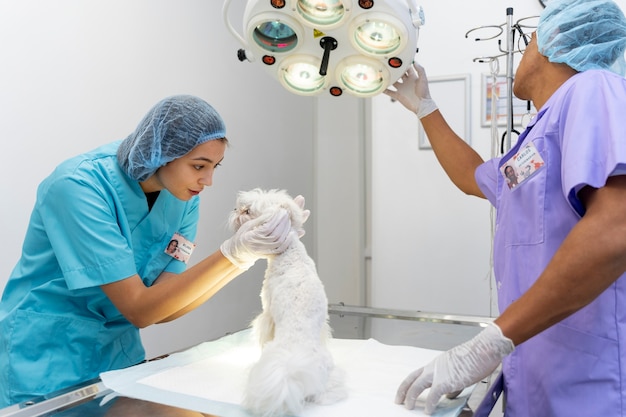When Your Pet Is Limping: Causes and Next Steps


When Your Pet Is Limping: Causes and Next Steps
If your beloved dog or cat is suddenly favoring a paw, refusing to put weight on a limb, or moving with an unusual gait, it is natural to feel concerned. Limping can have a wide range of causes, from minor injuries to more serious health conditions. At Lotus Animal Hospital FU, located conveniently at 5215 Windward Parkway, Alpharetta, GA 30004, our veterinary team understands how distressing it can be to see your pet in discomfort.
In this blog, we will answer the common question, "why is my pet limping?" by exploring the most frequent reasons behind limping in pets, how to recognize signs that indicate a problem, and the value of modern pet diagnostics in Alpharetta. We will also discuss how holistic care may support your pet’s comfort and healing, what you can do at home, and when it’s time to schedule a professional evaluation. Our goal is to give you peace of mind and guide you through the steps for restoring your pet’s mobility—so you can enjoy more happy walks, playtime, and cuddles together.
If you are searching for a "vet near me" who offers comprehensive pet diagnostic laboratory services in Alpharetta, our team is here to help. Should you notice any sudden changes in your pet’s movement, do not hesitate to reach out for a wellness examination so we can identify the cause and recommend the best path forward.
Recognizing Limping and Mobility Problems in Pets
It can sometimes be difficult to tell if your pet is truly limping or just moving differently for a moment. However, attentive pet owners often notice subtle changes in the way their dog or cat walks, runs, or stands. Key symptoms of limping include a noticeable reluctance to put weight on one leg, repeated licking or chewing at a paw or limb, swelling, and sensitivity to touch. You may also see them holding a limb up, favoring one side, or struggling to rise from a resting position.
Other warning signs are changes in activity level, such as not wanting to go for walks, difficulty jumping onto furniture, or appearing less playful than usual. Sometimes your pet might vocalize, whine, or yelp when moving or being touched. In some cases, limping can be intermittent—appearing worse after rest or more pronounced after activity. Observing these patterns gives your veterinarian important information during your visit.
If your pet’s limping is accompanied by bleeding, severe swelling, a dangling limb, sudden inability to walk, or signs of pain that prevent them from eating, drinking, or using the bathroom, these are urgent concerns. In these situations, you should seek immediate veterinary attention.
Why Is My Pet Limping? Common Causes
Understanding why your pet is limping begins with recognizing the many possible causes. Dogs and cats may limp due to injuries, chronic conditions, or even subtle issues that develop over time. Some of the most frequent reasons for limping include soft tissue injuries such as sprains, strains, or bruising, which often occur after rough play or slipping on slick surfaces. Cuts, wounds, or foreign objects like thorns lodged in the paw can also cause sudden limping and localized discomfort.
Joint problems such as arthritis are a common source of chronic limping, especially in older pets. Signs of arthritis-related limping often include stiffness after rest, reduced mobility, and gradual worsening over time. Pets may also develop ligament injuries, like cranial cruciate ligament tears in dogs, or patellar luxation (kneecap dislocation), especially in certain breeds. In some cases, bone injuries such as fractures or bone infections can cause acute or persistent lameness.
Other causes include hip or elbow dysplasia, which are inherited conditions affecting the joints, as well as nerve injuries, tumors, or conditions like Lyme disease, which can affect the joints and cause shifting lameness. Even overgrown nails, paw pad burns from hot pavement, or insect stings can result in a limp.
In the warm and humid climate of Alpharetta and surrounding communities, pets are more likely to pick up ticks, develop paw injuries from hot sidewalks, or experience slips during rainy seasons. Being aware of regional risks helps you stay proactive about your pet's health.
Diagnostic and Treatment Options for Limping Pets
When your pet is limping, a thorough veterinary evaluation is the safest way to determine the underlying cause and develop an effective treatment plan. At Lotus Animal Hospital FU, our veterinarians begin with a comprehensive physical examination, assessing your pet’s gait, range of motion, and any areas of swelling or tenderness. We will ask about recent activity, how and when the limping started, and if your pet has any known injuries or medical history.
For many cases, advanced pet diagnostics in Alpharetta are essential. Our in-house diagnostic laboratory allows us to check for infection, inflammation, or underlying health conditions through bloodwork and other lab tests. Imaging techniques such as digital radiology provide detailed pictures of bones and joints, helping us identify fractures, arthritis, or hidden injuries. In some situations, ultrasound imaging is used to visualize soft tissue injuries or detect fluid buildup in joints.
Treatment approaches depend on the diagnosis. For minor injuries, rest, cold compresses, and short-term pain relief may be recommended. Infections or wounds are treated with appropriate medications and wound care. Chronic joint conditions like arthritis in pets often benefit from a combination of anti-inflammatory medications, weight management, and supportive therapies.
At Lotus Animal Hospital FU, we are proud to offer holistic care solutions that support your pet’s recovery and comfort. Acupuncture, for instance, can help manage pain and inflammation, while dietary supplements or laser therapy may promote joint health and healing. Severe injuries, such as fractures or ligament tears, may require surgical intervention, which our experienced veterinary professionals are equipped to provide with compassionate post-operative care.
Home Care and Preventive Strategies
While professional assessment is always recommended for limping pets, there are steps you can take at home to support your pet’s comfort and prevent future injuries. Ensuring your pet maintains a healthy weight reduces stress on joints and prevents many mobility problems. Providing non-slip surfaces in your home, trimming your pet’s nails regularly, and avoiding excessive jumping from high places all help protect your pet’s legs and paws.
If your pet is limping mildly and there is no visible wound or severe pain, you can encourage rest by limiting activity and keeping walks short and slow. Applying a cool compress for brief periods may ease swelling. Always monitor for changes—if the limping does not improve within a day or two, or if it worsens, it’s time to schedule a veterinary visit.
For pets with arthritis or chronic joint issues, your veterinarian may suggest joint supplements, gentle exercise, and physical therapy. Holistic approaches such as acupuncture or therapeutic massage can also provide comfort and improve mobility. Preventive care, including regular wellness examinations, allows our veterinary team to detect early signs of joint disease and recommend tailored strategies for your pet’s long-term health.
When to Seek Veterinary Care for Limping
It can be difficult to judge when limping is a minor issue versus a sign of something more serious. You should always contact your veterinarian if your pet’s limping lasts longer than 24 hours, worsens over time, or is accompanied by swelling, heat, or obvious pain. Seek immediate veterinary attention if your pet cannot bear weight on a limb, has visible bone or joint deformity, severe bleeding, or shows signs of systemic illness such as fever, lethargy, or loss of appetite.
Early diagnosis and intervention make a significant difference in your pet’s recovery and comfort. Finding quality veterinary diagnostics in Alpharetta ensures your pet receives the right care as soon as possible. Our veterinary professionals at Lotus Animal Hospital FU are here to help you determine the next steps, whether that involves advanced imaging, lab testing, or referral to a specialist if needed.
If you are searching for the "best veterinarian near me" to evaluate your pet’s mobility, trust our experienced team for compassionate care and state-of-the-art diagnostics.
Take the Next Step: Restore Your Pet’s Comfort and Mobility
Watching your pet limp is never easy, but you do not have to navigate this challenge alone. At Lotus Animal Hospital FU, we are dedicated to providing thorough pet diagnostics in Alpharetta and surrounding communities, so you can have answers and peace of mind. Whether your pet’s limp is mild or severe, scheduling a comprehensive pet exam is the safest way to uncover the cause and plan the best treatment.
If you are ready to help your pet move comfortably again, call us at (732) 915-3664 or visit our Alpharetta location to schedule an appointment. Our veterinary team welcomes you with personalized attention, advanced diagnostics, and holistic treatment options to get your pet back on their paws.
For pet owners searching for a "vet near me" who provides quality veterinary services near me, Lotus Animal Hospital FU is your trusted partner in lifelong pet health. Let us support you and your pet every step of the way—because every wag, purr, and playful leap matters.
This blog is intended for informational purposes only and does not replace individualized veterinary advice. If your pet is limping or in distress, schedule an examination with your veterinarian for a proper diagnosis and treatment plan. For more information about limping in pets, you may find additional resources at the American Veterinary Medical Association.





















